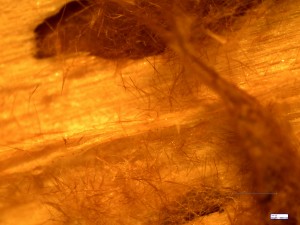Phellinus sulphurascens
Phellinus sulphurascens is the indigenous fungal pathogen of Western North America that causes laminated root rot in conifer trees.
Identification:
A close-up image of the red whiskers that are characteristic of P. sulphurascens.
Hosts: Douglas-fir and other conifers.
Distribution: Klamath mountains of Northern California to the uppermost limit of P. menziesii in British Colombia, and east to Idaho (Thies and Sturrock 1995)
General Information: P. sulpharescens spreads mycelia ectotrophically, penetrating the bark on roots of trees and killing phloem and cambium, then decaying the xylem (Wallis and Reynolds 1965). It spreads vegetatively underground through root to root contact between trees, moving circularly outward from an epicenter of infection, creating in the forest a ring of tree death and decay that we will call an “infection center”. It is a sporulating basidiomycete fungi, although it does not typically form a fruiting body, and its reproduction is based on cloning its mycelial colonies. Due to this reproductive adaption most areas of infection contain, or are dominated by, only a single genet of P. sulphurascens (Childs 1963). Infected trees may be those declining in health, and therefore more susceptible to attack by pathogen, or they may be the most vigorous and long-lived trees in the stand. Trees of all sizes and ages are susceptible. Infected trees may maintain a significantly thinned and discolored canopy and live for many years as the root system is slowly decayed by the fungus, until eventually the tree falls over or is windthrown, breaking above the roots and leaving roots and stump in the ground (Maser et al 1988). Viable inoculum has been shown to survive saprophytically in dead roots and buried stumps for 50 years after tree mortality (Matson and Boone 1984; EM Hansen 2000). Studies have shown infection centers to expand up to 30-50 cm annually, although expansion is uneven throughout the stand (Nelson and Hartman 1975; McCauley and Cook 1980; Matson and Boone,1984). Wallis and Reynolds (1965) have recorded survival of distinct individual organisms up to 100 years, although the abundance of viable inoculum begins to decline half way through this lifespan.
As infection centers expand larger trees are removed, creating gaps in the canopy, and an opportunity for diversification of the understory. P. menziesii is not a species known to establish regrowth in infection centers, although many other successional species do show resistance to P. weirii in regrowth areas (Hansen and Goheen 2000), and may indeed thrive there. Both Tsuga heterophylla (Western Hemlock) and Thuja plicata (Western Red Cedar), two dominant climax species of succession in the temperate forests of Western Washington, appear to be resistent to P. sulphurascens (Hansen and Goheen 2000). This indicates an ecological role of P. sulphurascens as a catalyst of succession, pushing ecosystems past the Douglas Fir dominated stage and towards the climax stage characteristic of old growth forest dominated by Western Hemlock and Western Red Cedar.
Economic Impact
(Goheen and Hansen, 1993)
Phellinus sulphurascens causes annual losses estimated at 900,000 m3 of wood in Oregon and Washington forests (Childs and Shea, 1967) and 1,050,000 m3 in British Columbia (Wallis, 1967). These estimates do not result from actual surveys but rather are based on projections that at least 5% of the area occupied by the P. menziesii forest type is affected, and losses within infected areas approach 50% over a rotation. No regional root disease surveys have been done, but the few local surveys suggest that perhaps even larger proportions of this forest type may be affected. Within Phellinus weirii centers, reduction in Pseudotsuga menziesii volume has been measured at 10% (Bloomburg and Reynolds, 1985) to 55% (Goheen et al., unpublished data).

Leave a Reply